The main types of personal protective equipment. Individual protection means
Facilities personal protection respiratory organs (RPE)
In the context of the use of weapons mass destruction and man-made disasters, it is necessary to have, know and use personal protective equipment. Personal protective equipment includes respiratory protection (RPE), skin, medical devices. Personal protective equipment protection organs breathing include filtering and insulating gas masks, respirators, masks, bandages. Filtering personal protective equipment purifies the amount of air necessary for life from harmful impurities and toxic substances. insulating from personal protective equipment completely isolates the respiratory organs from the external environment, supplying oxygen from a special cartridge. By efficiency better protection provide gas masks - in addition to respiratory protection, they provide eye and face protection. The action of filtering gas masks is based, as the name implies, on the purification of inhaled air. Gas masks GP-7, GP-5 are used for the civilian population.
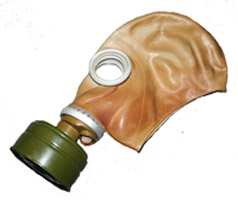
Civilian filtering gas mask GP-7 and GP-5
Insulating gas masks used when filtering gas masks do not provide the proper degree of protection, or when there is not enough oxygen in the air. The source of oxygen in such a gas mask is a special cartridge equipped with a special substance. For the needs of the population, insulating gas masks IP-4M, IP-5, IP-6, IP-7 are produced. 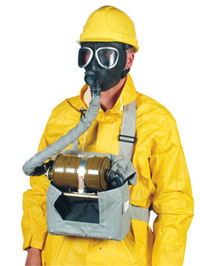
When unavailable, as well as in situations where the use of gas masks does not make sense, you can use respirators, masks and half masks. Filtering antiaerosol half masks are classified in accordance with GOST R 12.4.191-99 according to the degree of protection - FFP1, FFP2, FFP3. In this case, FFP is the coefficient of penetration of harmful substances, i.e. how many percent of harmful substances the half mask should filter out.
FFP1 - 22% (up to 4 MPC) - low efficiency, protection against coarse solid aerosols
FFP2 - 8% (up to 12 MPC) - medium efficiency, protection against fine solid and liquid aerosols
FFP3 - 2% (up to 50 MPC) - high efficiency, against fine solid and liquid aerosols
It follows from the above that you need to purchase at least the FFP2 protection class - a respirator with this protection class will filter out up to 92% of harmful substances, which is much more effective compared to FFP1 (78%). FFP3 respirators and half masks provide maximum protection - up to 98%, but their cost is slightly higher than the FFP2 protection class. It should also be noted that the higher the protection class, the more difficult it is to breathe in them. FFP2 and FFP3 respirators are often equipped with an exhalation valve to prevent moisture buildup inside the respirator. In addition to the penetration coefficient, the degree of protection is characterized by the maximum permissible concentration of harmful substances - MPC. Thus, a respirator of protection class FFP2 provides adequate protection when the amount of harmful substances in the air does not exceed 12 MPC. 
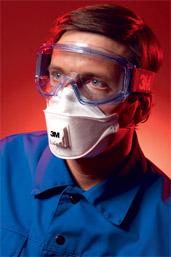
Disposable filtering half mask (respirator) 3M 8101 and 3M 9312
Different models of antiaerosol respirators and half masks are produced with additional protection against various harmful substances - acid gases and vapors of inorganic substances (chlorine, sulfur dioxide, hydrogen chloride and fluoride), vapors and gases of organic origin (vapors of solvents, gasoline, toluene), vapors of basic substances and basic gases (ammonia, amines, aniline). Compared to respirators and half masks, filtering masks with replaceable filters provide full face protection, which is similar, for example, to a gas mask GP-7, but due to the panoramic lens, provides a larger angle of view . 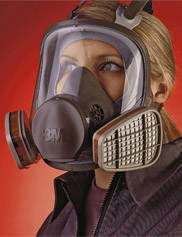
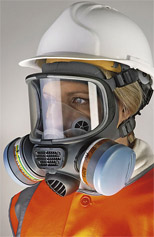
Filter mask 3M 6700 and SPIROTEK FM9500
Means of individual skin protection.
Such products protect the skin from exposure to toxic substances, radioactive and biological particles. Individual skin protection products fully protect against heavy particles of alpha radiation, partially from beta radiation. Personal protective equipment for the skin is divided into insulating and filtering. Insulating means are made of airtight materials. In this case, skin protection products can be sealed and not sealed. Sealed skin protection products provide protection against vapors and droplets of toxic substances, not tight only against drops of toxic substances. The insulating personal protective equipment for the skin includes the combined arms protective kit - OZK. Consists of a protective raincoat, gloves, protective stockings. Cloak fabric provides protection against toxic, radioactive and bacterial agents. 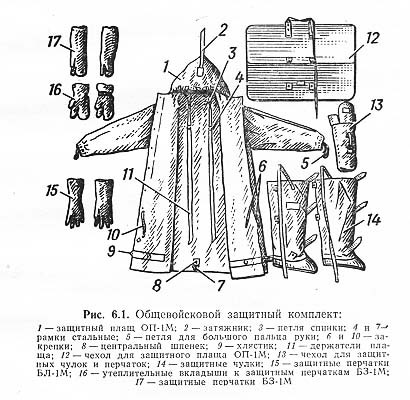
Combined Arms Protective Kit - OZK
Protective clothing also includes a light protective suit made of rubberized fabric, consisting of a jacket with a hood, trousers sewn with protective stockings, gloves and a balaclava. As an option, light protective overalls are produced, which differ from the suit only in that the jacket and trousers are made in the form of overalls. 
Lightweight protective suit
Filtering personal protective equipment for the skin includes protective clothing made of cotton fabrics with a special impregnation that allows clothing to breathe, but does not let in toxic substances (within reasonable limits).
It is also worth noting that protective clothing, with minimal sewing skills, can be made by yourself for all family/team members from modern lightweight fabrics, because protective clothing First of all, it is designed to protect you, and not to impress with the ideal cut.
Module No. 16
Topic:
INDIVIDUAL PROTECTION MEANS
Educational element - 0.
integrating goal:
As you work on learning elements, you should:
know:
Personal respiratory protection;
Personal protective equipment for skin;
Medical personal protective equipment;
be able to:
Use personal protective equipment;
Methyl chloride
carbon monoxide
Ethylene oxide
Hydrochloric acid
hydrogen sulfide
ethyl mercaptan
However, in emergency situations caused by large-scale releases of hazardous chemicals, when high concentrations can be created in the atmosphere that are several orders of magnitude higher than from agents in the field, the time of the protective action of a gas mask is very limited. And in some cases it is equal to zero. This is due to the fact that, firstly, they do not provide protection against a number of hazardous chemicals, such as ammonia, dimethylamine, methyl chloride, nitrogen oxides, ethylene oxide, carbon monoxide. Secondly, in the immediate vicinity of the source of contamination, where, as a rule, very high concentrations, an instantaneous breakdown of the charge of the gas mask box can occur.
In order to expand the capabilities of the gas mask to protect against various hazardous chemicals and improve the protective properties, the industry produces special additional hopcalite cartridges DP-1, DP-2, DPG-1, DPG-3 and PZ. An additional hopcalite cartridge is used together with an anti-gas filter-absorbing box. There is one (DPG-3) or two (DPG-1) layer inside the cartridge: a special absorber and hopcalite. Outside air, getting into the filter-absorbing box (FPC), is preliminarily cleaned from aerosols and vapors of hazardous chemicals. Then proceeding to additional cartridge, finally cleared of harmful impurities.
In order to expand the capabilities of a gas mask to protect against various hazardous chemicals and improve their protective properties, the industry produces special additional hopcalite cartridges DP-1, DP-2, DPG-1, DPG-3 and PZ. An additional hopcalite cartridge is used together with an anti-gas filter-absorbing box. There is one (DPG-3) or two (DPG-1) layer inside the cartridge: a special absorber and hopcalite. Outside air, getting into the filter-absorbing box (FPC), is preliminarily cleaned from aerosols and vapors of hazardous chemicals. Entering then into an additional cartridge, it is finally cleared of harmful impurities.
Industrial gas masks designed to protect the respiratory system from specific hazardous substances inherent in this production. The protective properties of boxes of industrial gas masks are much higher than boxes civilian gas masks and they can be used over a wider range of concentrations.
For the protection of workers and employees at the HOO associated with the production or use in technological processes AHOV, special industrial gas masks are used, which are equipped with boxes (FPK) of large dimensions, specialized for their intended purpose.
The duration of the protection of industrial gas masks of large dimensions from AHOV and other substances depends on the brand of the box (Table 2), the type of substance and its concentration.
Table 2.List of boxes of industrial gas masks
box type | Color boxes | From what substances protects |
Brown | Organic vapors (benzene and its homologues, gasoline, kerosene, acetone, haloorganic compounds, nitro compounds of benzene and its homologues, ethers, alcohols, ketones, aniline, tetraethyl lead, carbon disulfide), phosphorus and fluorographic pesticides. |
|
Acid gases and vapors (chlorine, sulfur dioxide, hydrogen sulfide, hydrocyanic acid, chloride hydrogen, phosgene, etc.), phosphorus and organochlorine pesticides. |
||
Black with yellow | Mercury vapor, organomercury compounds. |
|
Arsenic and phosphorous hydrogen. |
||
Orange | Radionuclides, including methyl iodide and other organic compounds of radioactive iodine. |
|
Ammonia, ethylene oxide. |
||
Ammonia, hydrogen sulfide and its mixtures. |
||
IFF BKF | Protective | Vapors of organic compounds, acid gases, vapors (but with a shorter hold time than A and B boxes), arsenic and phosphorous hydrogen. |
Nitrogen tetroxide. |
||
Carbon monoxide. |
||
Carbon monoxide in the presence of vapors of organic substances, acid gases, ammonia, arsenic and phosphorous hydrogen. |
The approximate time of the protective action of a box of industrial gas masks for protection against hazardous chemicals at a maximum concentration is from 0.3 to 0.6 hours, depending on the type of hazardous chemicals.
The device of the filtering gas mask GP-5
The GP-5 gas mask (Fig. 2) is the main gas mask in service with the civil defense. It is characterized as a civilian, filtering, box gas mask. Designed for use by older students and adults. It is a universal means of respiratory protection, as it simultaneously protects both the respiratory organs, and the face and eyes from radioactive, toxic, some emergency chemical hazardous substances and bacterial (biological) agents.
Gas mask GP-5 consists of two parts:
Front part: ShM-62 mask;
Filter-absorbing box (FPK) of small size GP-5.
DIV_ADBLOCK49">
Filtering and absorbing box(FPK) is designed to clean the inhaled air from radioactive, toxic substances and bacterial agents. Special absorbers and a smoke filter are placed in the metal case of the box. When inhaling, the air entering the box first passes through the filter, on which particles of dust, smoke, fog remain, and then through absorbers, where OM vapors are retained.
The filter-absorbing box consists of the following parts:
▪ anti-aerosol filter that traps biological aerosols, radioactive dust and harmful aerosols (dust, smoke, mists);
▪ charge - activated carbon - absorbs OM, AHOV and other harmful substances;
▪ tampon paper retains the coal dust of the charge;
▪ top and bottom grids hold charge;
▪ The screen distributes the air flow.
Bag designed to accommodate a gas mask in it and to carry it. The bag can also be used as an additional filter, if you tie it on the FPC with a ribbon, increase protective properties this can be done by wetting the bag with water.
Masks ShM-62u gas masks GP-5 are available in five sizes:
Size | |||||
Head size | from 63.5 to 65.5 cm | from 66 to 68 cm | from 68.5 to 70.5 cm | over 71 cm |
The size is determined using a centimeter tape by vertically measuring the size of the head. A centimeter tape is drawn from the tip of the chin through the crown and ends at the tip of the chin. According to the testimony and determine the size of the gas mask.
To put on a gas mask hold your breath, close your eyes headdress, take out the helmet-mask and take it with both hands by the thickened edges at the bottom so that the thumbs are outside and the rest are inside. Then you should put the lower part of the helmet-mask under the chin and with a sharp movement of the hands up and back pull it over the head so that there are no wrinkles, and the spectacle knot falls against the eyes. After that, exhale completely, open your eyes and resume breathing. Then you can put on a hat and fasten the gas mask on your side.
Guidelines for putting on a gas mask
Condition for fulfilling the standard | grade |
||
Great | Okay | satisfactory |
|
From the position of the gas mask "at the ready" | |||
From the traveling position of the gas mask |
Errors that reduce the score by one point:
When putting on a gas mask, do not close your eyes;
When putting on a gas mask, the breath is not held;
A sharp exhalation was not made after putting on a gas mask;
The helmet mask is not fully and incorrectly put on.
Respirators. Respirators are used to protect the respiratory organs from harmful gases, vapors, aerosols and dust. At their core, they are personal means of protecting the respiratory system from harmful substances contained in the air. They are widely used in mines, mines, chemical and metallurgical enterprises, nuclear power plants, when working with fertilizers and pesticides in agriculture. Respirators are classified by purpose, device and service life.
By appointment respirators are divided into anti-dust, anti-gas and gas-dust protection.
By device respirators are divided into two types:
Respirators in which the half mask and the filter element simultaneously serve as a facepiece;
Respirators that purify the inhaled air in filter cartridges attached to the half mask.
By service life respirators are divided into disposable and reusable respirators (they provide for the replacement of filters).
The type of respirator is chosen depending on the characteristics of harmful substances and their maximum allowable concentration in the air.
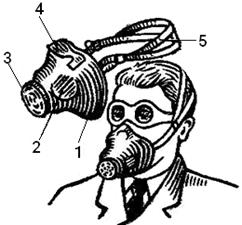 In service and civil defense, the most widely used dust respirators R-2, U-2K (Fig. 3), ShB-1 "Petal", "Kama" and others. In emergency situations at radiation hazardous facilities, as well as in wartime conditions, these respirators can be used to protect the respiratory organs from radioactive dust and biological weapons. These respirators do not provide protection against vapors and gases of harmful substances.
In service and civil defense, the most widely used dust respirators R-2, U-2K (Fig. 3), ShB-1 "Petal", "Kama" and others. In emergency situations at radiation hazardous facilities, as well as in wartime conditions, these respirators can be used to protect the respiratory organs from radioactive dust and biological weapons. These respirators do not provide protection against vapors and gases of harmful substances.
Fig.3. Respirator R-2 (U-2K)
1 - half mask,
2 - inhalation valve,
3 - exhalation valve,
4 - nose clip,
5 - headband.
The most widely used are anti-dust respirators R-2, U-2K, Kama, ShB-1 Petal and others. In conditions emergencies these respirators can be used to protect the respiratory system from radioactive dust and bacterial agents. However, it should be borne in mind that dust respirators do not provide protection against vapors and gases of harmful and toxic substances.
In the event of a threat of radiation, chemical or biological contamination, medical protective equipment will be issued at special organized points for issuing PPE.
Medical PPE includes:
First aid kit individual AI-2;
Individual anti-chemical package IPP-8 (IPP-10, IPP-11);
Individual dressing package (IPP);
Preventive antidote P-10M.
First aid kit individual AI-2 It is designed to provide self - and mutual assistance in case of injuries and burns (to relieve pain), to reduce damage from RV, OV or AHOV, as well as to prevent infectious diseases.
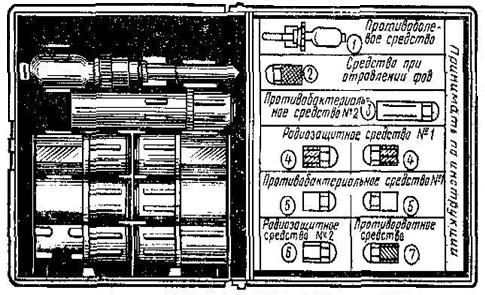
Fig.11. First aid kit individual AI-2
The means included in the first-aid kit are placed in a plastic case. The contents of the first-aid kit are a syringe tube and pencil cases of different colors with medicines.
In the cold season, the first-aid kit is carried in the inner pocket of clothing to prevent freezing.
The composition of the first-aid kit AI-2 includes:
socket 1(analgesic) - a syringe tube with a 2% solution of promidol (or morphine) - a strong pain reliever that is administered intramuscularly for wounds, burns and severe injuries.
nest 2(an agent against organophosphorus substances) - taren - an antidote against organophosphorus poisonous substances, which include sarin, soman and WX gases. There are 6 tablets in a red case. Take 1 tablet under the tongue, then put on a gas mask. This is a preventive measure when declaring a chemical hazard with the use of an FOV-type agent or the need to stay in areas contaminated with FOV. With the appearance and increase of signs of poisoning (miosis of the eyes, blurred vision, shortness of breath), after 6 hours it is necessary to take another pill.
nest 3(antibacterial agent No. 2) - a pencil case with 15 tablets of sulfadimethoxine. Taken for gastrointestinal disorders caused by external radioactive radiation or the action of bacterial agents, 7 tablets at a time on the first day and 4 tablets in the next two days.
socket 4 (radioprotective agent No. 1) - two pink pencil cases with six cystamine tablets each. Rapid action radioprotector. It is used as a prophylactic agent that enhances the protective actions of the human body itself. Take 6 tablets at a time 30-60 minutes before the expected exposure. The radioprotective effect occurs after 40-60 minutes and lasts for 4-6 hours. Re-admission is possible after six hours at the same dose in case of being in a territory contaminated with radioactive substances.
nest 5(antibacterial agent No. 1) - two pencil cases with five tablets of tetracycline each. Tetracycline - antibiotic wide spectrum of activity. It is taken when threatened or infected with bacterial agents, as well as for severe wounds and burns as antiseptic to prevent infection, first the contents of one case 5 tablets at a time and then after 6 hours the contents of the second case (5 tablets).
socket 6(radioprotective agent No. 2) - a pencil case with 10 tablets of potassium iodide. Used to protect the thyroid gland from radioactive iodine. It is used when you are in a radioactively contaminated area and if you suspect the use of food, water, etc. contaminated with radioactive substances 30-40 minutes before the expected exposure at a dose of 1 tablet daily for 7-10 days, or until the threat of admission disappears radioactive isotopes of iodine into the body.
nest 7(antiemetic) - a pencil case with 5 tablets of etaperazine or aeron. Take one tablet immediately after exposure to prevent vomiting, as well as head bruises, concussions and concussions, if nausea occurs. The action lasts 4-5 hours after administration. With continued nausea and vomiting, you need to drink one tablet every 4 hours.
The use of AI-2 first aid kit preparations in the indicated doses is calculated for adults. For children under 8 years of age, it is necessary to give 1/4 of the adult dose, and from eight to 15 years - 1/2 of the dose.
In order to increase the effectiveness of medical protection of the population, it is planned to include more modern medicines in the AI-2 first aid kit. Instead of tetracycline - dixycycline, instead of etaperizine - the drug dimetcarb.
IN individual first aid kit there are no means of general calming action and weakening the feeling of fear. In emergencies, as practice has shown, these funds are necessary. Therefore, it is possible to recommend to the population for these purposes, in addition to the contents of the AI-2 first aid kit, to use tranquilizers (such as Elenium, Sibazon, Phenozepam).
Individual anti-chemical packages are intended for disinfection of drop-liquid agents and organophosphorus hazardous chemicals that have fallen on the body and clothing of a person, personal protective equipment and tools. Currently, there are various modifications of individual anti-chemical packages based on both liquid and powder degassing formulations. The GO is armed with the following types of individual anti-chemical packages: IPP-8, IPP-9, IPP-10, IPP-11.
Individual anti-chemical package IPP-8 consists of a flat glass bottle with a screw cap filled with a polydegassing solution, four cotton-gauze swabs and instructions enclosed in a sealed plastic bag. When using the package, you need to open its shell, unscrew the cap of the vial and moisten the swab with its contents. Thoroughly wipe the open areas of the neck and hands with it, wipe the outer surface of the gas mask helmet-mask. Then moisten the swab again and process the edges of the collar and cuffs of the sleeves adjacent to the skin. You should also process those areas of clothing and shoes where drops of RH are visible. When processing the skin, a burning sensation may be felt, but it quickly disappears and does not affect well-being. However, it must be remembered that the liquid of the package is poisonous and dangerous for the eyes, so the skin around the eyes should be wiped with a dry swab and rinsed with clean water or a 2% soda solution. The liquid of the vial does not have a disinfectant property.
IPP-9 represents aluminum cylindrical container with a screw cap. A punch is inserted into the bottle, on the top of which there is a foam rubber sponge. To moisten the sponge, you need to drown the punch to the stop, opening and turning the vessel, shake it two or three times. Wipe the skin of the face, hands, infected areas of clothing with a dampened sponge. After that, pull the punch out of the vessel and screw on the lid.
IPP-10 - cylindrical aluminum cylinder filled with Langlic-based polydegassing prophylactic protective formulation. The cylinder is fitted with a cap-nozzle with stops, which is attached to the strap. There is a punch hole inside the lid. When using, you need to turn the lid, move it from the stops and open the vessel with a blow on it; remove the lid and pour 10-15 ml of liquid into the palm of your hand; treat her face and neck in front. Then you need to pour another 10-15 ml of liquid and treat the hands and neck from behind. After that, close the bag with a lid and store it for reprocessing. Treatment of the skin is carried out 30-40 minutes before entering the focus of chemical contamination. In case of contact with the skin and clothing of RH or AHOV, treatment is carried out immediately. The liquid has a disinfecting effect and gives a protective effect for 12-24 hours by creating a protective film in the thickness of the skin.
IPP-11 is the most convenient and easy to use individual anti-chemical package. It is intended for the prevention of lesions in case of infection with any known agents of exposed skin. IPP-11 is a plastic disposable bag (36 g), in which a swab soaked in a special solution is sealed. The advantages of IPP-11 are:
▪ speed and area of skin treatment:
▪ convenience of processing the face under the front part of the gas mask;
▪ effective protection up to 6 hours;
▪ bactericidal;
▪ healing of minor wounds and cuts;
▪ treatment of thermal and chemical cuts.
In the absence of anti-chemical packages areas of the body and clothing can be treated with soap and water, using paper swabs, rags, or a handkerchief. It is better to do this when no more than 10 minutes have passed since the droplets hit the body and clothes.
As a degassing liquid, a solution prepared from one liter of 3% hydrogen peroxide and 150 g of silicate glue, which are mixed immediately before use, can be used.
The treatment of open areas of the body, carried out with the help of an individual anti-chemical package in the first minutes of infection, prevents skin damage and the penetration of OM into the blood. Treatment carried out at a later date may reduce, but not prevent, the development of the lesion. In these cases, an antidote must be administered after treatment.
Antidote P-10M used as a prophylactic against the threat of organophosphorus poisoning. It is used orally, 2 tablets per reception. The protective effect occurs after 30 minutes. The duration of action is 24 hours. Repeated use of the drug not earlier than 48 hours later.
The composition of medical PPE also includes an individual dressing package.
Individual dressing package used for dressing wounds and burns. It contains a disinfected dressing, which is enclosed in two shells: the outer one is made of rubberized fabric, with the method of opening and use printed on it, and the inner one is made of paper. There is a safety pin in the fold of the inner shell.
The shells ensure the sterility of the dressing, protect it from mechanical damage, dampness and contamination.
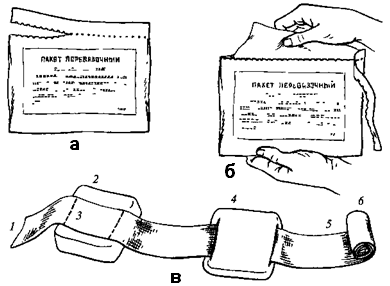 Rice. 13. Individual dressing package:
Rice. 13. Individual dressing package:
a - opening the outer cover
by incision;
b- removal of the inner packaging;
in- dressing material
expanded:
1 - the end of the bandage;
2 - the pillow is motionless;
3 - coloredthreads;
4 - cushion is movable
5 - bandage;
6 - bandage roll.
The material in the bag consists of a gauze bandage 10 cm wide and 7 m long and two equal-sized cotton-gauze pillows 17x32 cm in size. One of the pillows is sewn to the bandage, the other is connected to it movably and can move freely along the length of the bandage. Due to this, with penetrating wounds, it is possible to close the inlet and outlet wound openings with one package. Colored threads mark the surfaces of the pads, which can be grasped by hand when applying a bandage.
When applying a bandage, you must:
Open the package, remove the pin and pin it to the clothes;
Take the end of the bandage with your left hand, and roll the bandage with your right hand and unfold it;
Apply pads, without touching them to other objects, on the wound (burn) with the side that is not stitched with colored threads;
Bandage the pads, and secure the end of the bandage with a pin.
The top rubberized bag can be used to treat a chest wound (open pneumothorax) by closing the wound and bandaging it tightly to the chest.
ASSIGNMENTS for educational element - 4:
1. Read the text.
2. ♣ List medical personal protective equipment and indicate their purpose.
3. ♣ Name the composition and purpose of AI-2.
4. ♣ What does an individual dressing bag consist of and how to use it?
Personal protective equipment is specialized tools or equipment, the main purpose of which is to ensure human safety in the event of a threat from various toxic, radioactive, bacterial and other agents that can be harmful to life and health. At the same time, not everyone knows what such means are and where they are used in principle.
What are they like?
Depending on the purpose, such funds are divided into means for ensuring the safety of the skin, as well as respiratory organs. There is also a difference in the principle of how personal protective equipment ensures safety - these are insulating and filtering tools.
The principle of filtration in this case is that the air, which is required to maintain the normal functioning of the human body, in the case of passing through specialized protective equipment (for example, through a layer of activated carbon) is completely cleared of any harmful impurities.
Isolating type devices provide complete isolation of the human body from possible environmental impacts using specialized materials that are absolutely impervious to air and various harmful impurities that it contains.
Preparation method
There is also a difference in the technology used to make personal protective equipment - these are the simplest, improvised or industrial ones.
The accumulation of the required amount of industrial production, as well as the preliminary preparation of the simplest protective equipment made from various materials at hand, is a rather responsible job.
Storage

It is worth noting the fact that the organization of the storage of protective equipment is an extremely important measure in this case, because the storage places should be as close as possible to the conditions that are present at the place of work of the employees of the facility, and if necessary, each employee should be provided as soon as possible personal protective equipment is one of the most important rules. Among other things, the storage conditions of this property must comply with the requirements, as well as ensure its constant technical serviceability.
Basically, funds are stored in specialized boxes in disassembled form. Thus, boxes of gas masks, which are sealed with a special rubber stopper and cap, lie on the bottom of the box, after which bags and front parts are placed on the boxes. This property should be periodically inspected, and if necessary, all detected malfunctions should be eliminated as soon as possible. It is worth noting the fact that a qualified specialist must be present at the facility, who will monitor how personal protective equipment (GOST) is stored - this is also a rather important requirement. Such a specialist must fully know all the rules for storing such property.
Providing
In the event that a threat is present, the serving personnel must be provided with personal protective equipment as soon as possible, after which they must be kept in constant readiness. The personnel of various economic entities, as well as employees and workers, are provided with such funds directly at the enterprises of which they are employees. The rest of the non-working population, if desired, should receive them at their place of residence or study.
Filtering gas masks
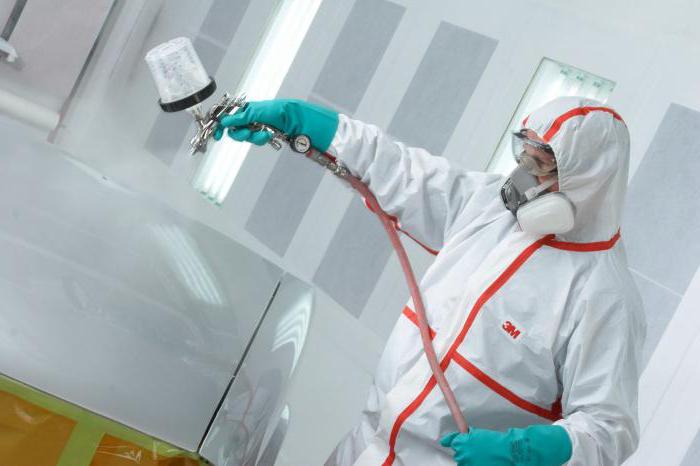
To provide effective respiratory protection for the adult population, filtering gas masks, like others, can be used.
In accordance with the rules of what personal protective equipment (GOST) should be, the GP-5 gas mask is a specialized box and front part. Among other things, the set of this device includes a specialized box equipped with anti-fog films, and a bag. Activated carbon is used as a filter element.
In terms of its dimensions, the GP-5 box has almost two times smaller dimensions compared to the GP-4, since its height is approximately 70 mm, while its diameter reaches 107 mm.
In accordance with how individual and personal protective equipment should look like, a standard rubber helmet-mask with fairings and goggles, as well as a special valve box with exhalation and inhalation valves is used as the front part of the GP-5 gas mask. The gas box must necessarily be screwed directly to the valve box.
How is the height of a helmet-mask determined?
Helmets-masks that are used in the gas mask model GP-5 have five height variations, which must be applied on both sides of the helmet without fail and are indicated by an Arabic numeral enclosed in a circle.
In order to determine the exact height of the helmet-mask, you need to measure the size of the head around the perimeter through points such as the cheek, chin and crown.
The measurement of the head is carried out using a special soft centimeter tape, and the results of measurements should be rounded up to 0.5 cm.
How to check the correctness?
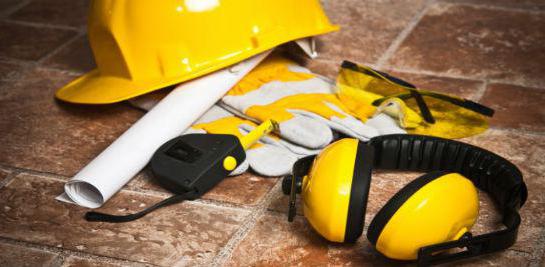
In accordance with the standards for how personal protective equipment is used, verification should be carried out as follows:
- The gas mask is taken out of the bag.
- The integrity of the goggle glasses and the helmet-mask itself is checked.
- The gas box is carefully inspected for all kinds of holes, dents, rust, the presence of valves and their condition are checked.
After a detailed external inspection, you will need to reassemble the gas mask and check how tight it is. To do this, a person must put on a helmet-mask, completely close the opening of the box with a rubber stopper, or simply hold it with his palm, and then take a deep breath. In the event that after this the air does not pass under the helmet at all, the gas mask is in good condition. If any malfunctions or missing components are found, such personal protective equipment in the workplace must be completely replaced.
How to wear a filter gas mask?
In accordance with how personal protective equipment for personnel should be used, the filtering gas mask can be worn in three main positions:
- Ready. Used only if there is an immediate threat of chemical, bacteriological or nuclear attack.
- Marching. Provides for wearing a gas mask over the right shoulder on the left side in the event that on this moment there is no threat of enemy attack.
- Combat.
When to wear a gas mask?

Initially, the use of a gas mask is provided in the process of performing various work associated with the risk of injury. respiratory tract, or in the production process with a similar hazard.
Also, in accordance with how personal technical protective equipment is used, the gas mask must be put on in advance in accordance with the order of the senior commander, or immediately upon the signals "Radiation danger", "Gas" or "Chemical alarm".
Skin protection
There are also specialized personal protective equipment against current and other injuries, which are designed to ensure the safety of clothing, shoes, open areas of the body and various items of equipment. Among other things, they allow you to completely stop the a-particles, and also significantly reduce the impact of b-particles. Depending on the principle of the protective action, such means are divided into filtering and insulating.
insulating
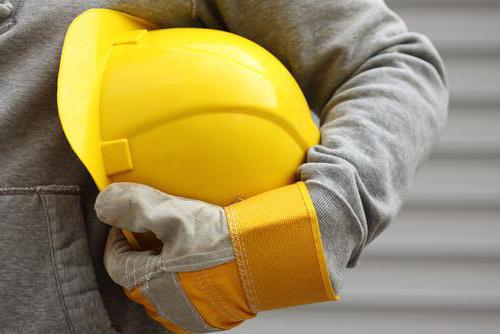
Insulating means are made of specialized airtight materials. Elastic is mainly used, as well as resistant to low temperatures. They can be leaky or sealed, the latter allowing you to completely close the entire body and provide protection even from drops of RH or vapors, while leaky products provide protection only from drops of RH.
The insulating protective equipment should also include a specialized and combined arms protective kit, as well as special footwear. Personal protective equipment of this type is used to ensure the safety of personnel in the process of working on terrain affected by various
Filtering
Filter protection means are even ordinary underwear and clothing if they are impregnated with a special soap-oil emulsion. Basically, such means represent only the primary provision of protection until access to specialized uniforms is gained.
Protective kit

The protective kit includes protective stockings, gloves and a raincoat.
This set is characterized by the presence of sides, sleeves, a hood and two floors, and is also equipped with fasteners, ribbons and straps, with which you can use such a raincoat in a variety of variations. The fabric from which such a raincoat is made allows you to achieve the maximum degree of protection against radioactive and toxic substances, as well as various bacterial agents or light radiation. The weight of such a raincoat is approximately 1.6 kg.
Rubber protective gloves have obturators made of a special impregnated fabric, and at the same time they can be summer or winter. In addition to the fact that they provide protection against all kinds of OM vapors, they are also individual means of protection against electric shock. Summer gloves are five-fingered, while winter gloves are two-fingered, and are also equipped with a special insulated liner fastened to buttons.
Stockings are made of a special rubberized fabric, while it is worth noting the fact that their soles are reinforced with a rubber or tarpaulin boot. Stockings with a canvas bottom are distinguished by the presence of two or three ribbons in order to ensure a secure attachment to the leg, as well as one in order to be attached to the waist belt. Stockings with a rubber bottom are fastened to the legs with straps, while their ribbon is used to fasten to the waist belt.
Thus, personal protective equipment of the Ministry of Emergency Situations and other types is now used in almost all areas of human activity, ranging from minor repairs to the danger of infection with various substances. Many do not even suspect that at their enterprise or in their office there is a whole set of such equipment, which, perhaps someday, will save their life in the event of a particular critical situation, while others use personal protective equipment in the process of carrying out their routine work, even without considering them something special.
- How to cook haddock: dinner recipes How to cook delicious haddock
- Daifuku Mochi: Japanese sweets
- How to bake the most delicious honey cake with sour cream
- Hot salted mushrooms in brine
- Pies "Bombochki" with tomatoes and cheese
- The recipe for delicious and tender sour cream cakes in the oven with a photo Delicious buns on sour cream with mayonnaise
- Recipe for cooking kalachi in the oven from grandma Sour cream knuckles recipe
- Capers in cooking What is better to cook with capers
- Cottage cheese soufflé - a delicate dessert Cottage cheese and banana soufflé in the microwave
- Resounding crunch, light snack: organic beetroot chips
- Fable wolf and lamb - popular expressions
- Modern ways of getting education
- The emergence and development of the state in ancient Egypt
- Natalia basovskayaLegends and myths of ancient Greece and ancient Rome
- See what "1937" is in other dictionaries
- Factors affecting health The health of mankind is largely dependent on
- Review of Lucretius's poem "On the Nature of Things" Review of Lucretius's poem "On the Nature of Things"
- Psychodiagnostic possibilities of conversation Questionnaires as a standardized self-report
- Scientists have uncovered the secret of the oldest Egyptian pyramid
- Timeline and results of the Crusades









